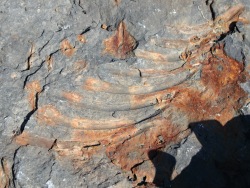An ancient reptile is found on Russky Island

A fossil of an ichthyosaur that lived about 247 million years ago has been spotted on Russky Island. It is probably one of the most ancient marine reptiles from the Triassic of Russia.
The unique paleontological object was first seen by seven-year-old Dima Sirenko. Though the boy is in Year One at school, he is no stranger to ancient reptiles. Dima participates in “Science and Travelling. Primorye” project bringing together the territory’s residents and scientists. For several years the family team called “Sirens” has explored the coast of Primorsky Territory, hoping to uncover a skeleton of some prehistoric creature.
“I like dinosaurs a lot, and I have always dreamed of finding bones of a real dinosaur,” said Dima. “All the time I was examining stones and asking Mom, “Maybe this is it?”. My sister and I played on the seashore and found this unusual stone which turned out to be an ichthyosaur. And now I know everything about it.”
Experts from all over the country were called on to identify the rare find. Scientists from Blagoveschensk – the Bolotskys, father and son - were among the first to arrive at the site. The father, Yuri Bolotsky, is a paleontologist who has become legendary not only in Russia but also across the world. The prominent scientist leads the Paleontological Laboratory at the Institute of Geology and Nature Management, FEB RAS.
The scientists determined that the ichthyosaur lay on its right side: ribs embedded in rock were clearly visible on the stone, and supposed that a vertebral column of the prehistoric reptile was preserved too. The paleontologists hope that the discovered slab contains some other petrified remains of the animal.
“The question - if there are some fragments of skull in the rock - is still intriguing us. But this ichthyosaur may have had its head torn off back then, 250 million years ago,” said Yuri Bolotsky. “Triassic marine reptiles in Russia are poorly known. We presume that this ichthyosaur is tropical, of a very peculiar type, and, most likely, belongs to durophagous species, which means that the reptile crushed shells and ate mollusks. We could quite accurately determine the age of the find due to the reptile’s ribs being surrounded by ammonites. Yuri Zakharov, an acknowledged ammonite expert from the Far East Geological Institute, FEB RAS, dated the mollusks to the Middle Triassic.”
The scientists made a preliminary field analysis of the find and prepared the slab with the relics for transportation. The fossil has been handed over to the Primorsky Aquarium where it will undergo further research. Considerable work awaits scientists: they will have to “take apart” the slab by removing layer by layer to find out if there is a skull inside it and to define the species of the ichthyosaur.
In the Bolotskys’ opinion, the paleontological history of life is not even a book with missing pages but its tiny bits and pieces. A fossilized animal should be lucky enough to survive into modern times: of millions of once living organisms, very few have come down to us as fossils.